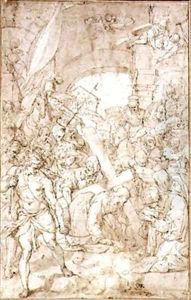Niccolo Circignano Paintings
Niccolò Circignano, also known as Niccolò Pomarancio or Il Pomarancio, was an Italian painter of the late Renaissance period, active mainly in Rome and Umbria. Born in the small town of Pomarance, near Volterra in Tuscany, around 1517 or 1518, his moniker, Pomarancio, is derived from his place of birth, a common practice of the time to distinguish artists of the same name. Despite the scarcity of documentation on his early life, it is believed that he began his artistic training in Tuscany, possibly influenced by the works of Andrea del Sarto and other Florentine masters of the time.
Circignano's career took a significant turn when he moved to Rome, where he became involved in the vibrant artistic scene of the late 16th century. In Rome, he was exposed to the works of Michelangelo, Raphael, and other Renaissance masters, whose influence is evident in his style, characterized by dynamic compositions, robust figures, and a vivid use of color. He was particularly known for his fresco paintings, which adorned many churches and public buildings in Rome and other Italian cities.
One of his most notable works is the series of frescoes in the Cathedral of Orvieto, where he was commissioned to continue the decoration of the San Brizio Chapel, a task originally started by Fra Angelico and later continued by Luca Signorelli. Circignano's contribution to the chapel includes scenes of the Apocalypse and the Last Judgment, showcasing his skill in depicting complex narrative scenes filled with emotion and drama.
Throughout his career, Niccolò Circignano also worked in various other cities in Italy, including Perugia and Spoleto, where he left a significant mark with his religious paintings and frescoes. Despite his contributions to the Italian Renaissance, his works have been somewhat overshadowed by those of his more famous contemporaries, and as a result, his name is not as widely recognized outside of art historical circles.
Niccolò Circignano died in 1596, leaving behind a legacy of work that, while not as celebrated as that of some of his peers, played an important role in the development of late Renaissance art in Italy. His paintings and frescoes continue to be studied and admired for their vibrant energy, expressive figures, and the insight they provide into the religious and cultural milieu of 16th-century Italy.
